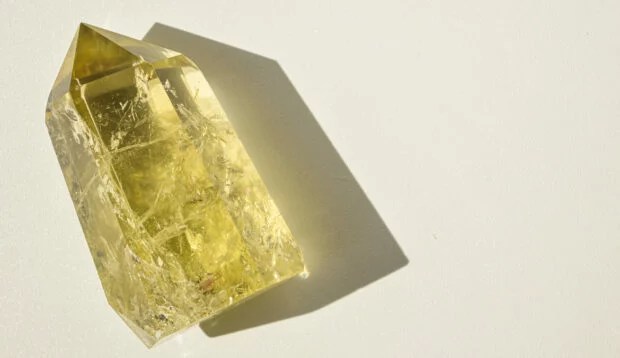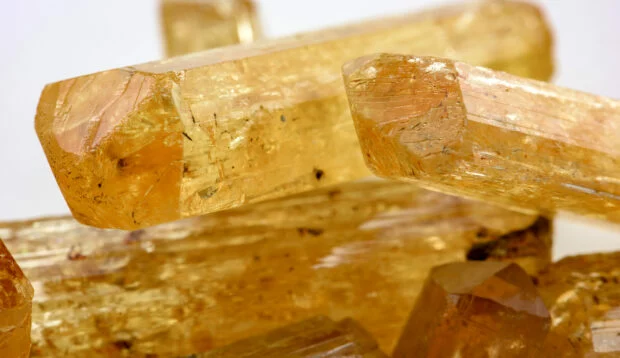To learn more about the November birthstones, crystal experts break down their meaning and expound on how folks, particularly Scorpios and Sagittarians born this month, can benefit from their metaphysical properties.
Properties of topaz, November’s traditional birthstone
- Birthstone color: Yellow
- Element: Fire and earth
- Planet: Sun and Jupiter
- Chakra: Third chakra
- Origin: Varied
Topaz is classified as a gemstone, and it comes in a range of hues, like blue, green, orange, red, pink, and purple. It’s sourced from all over the world, like the United States, Brazil, Russia, and China, and though it’s found across the globe, numerologist and certified crystal healer Joy Woodward says that it’s rare to find compared to other precious stones. Like other gemstones, topaz varies in value according to its color, clarity, cut, and carat—and, according to integrative medicine and crystal expert Elizabeth Trattner, AP, DOM, Imperial Topaz is among the most prized and coveted of this variety. It’s yellow topaz, however, that’s commonly associated with the month of November, says Woodward.
Birthstone meaning and symbolism of topaz
When it comes to its metaphysical properties, yellow topaz can help“align your thoughts, your actions, and your energy,” says Woodward, making it an ideal for manifestation. It allows you to envision a clear picture of what you want in your life and“grounds you in your intention,” so you don’t lose sight of the goals you want to achieve.
Whether you’re manifesting small or big goals, topaz can help you shake off the overly negative voices that prevent you from seeing your dreams as a possible reality. “It helps [you] realize [your] deservability for what you’re trying to manifest,” says Woodward. Moreover, topaz can also help you quell the anxiety that might arise as you’re working towards bringing your manifestations to life. According to Jill Wintersteen, astrologist, spiritual teacher, and founder of Spirit Daughter: “Topaz provides a calming effect,” and yellow topaz, in particular, “helps to bring positive vibrations and uplift the spirits.” As such, its calming capabilities can create a sense of peace and serenity while warding off self-doubt, so you can move towards your goals with steadfast certainty.
According to Dr. Trattner, yellow topaz is also associated with the third chakra (aka the solar plexus chakra), which Reiki healer Fern Olivia told Well+Good in an interview about the seven chakras, is the “action and balance chakra that focuses on individual willpower, personal power, and commitment.” Considering this association, it further reinforces the topaz’s ability in helping people commit to their goals and act upon them fearlessly.
Properties of citrine, November’s modern-day birthstone

- Birthstone color: Yellow
- Element: Fire and earth
- Planet: Sun
- Chakra: Third chakra
- Origin: Varied
Citrine is a stone of quartz family, and it typically comes in colors reminiscent of fall foliage, making it especially fitting for the month of November. Unfortunately, you won’t find a naturally occuring citrine without effort; according to Woodward and Dr. Trattner, natural citrines are rare. You’re more likely to come across amethysts that are heat treated to look like citrines, which has a yellowish color similar to its counterpart, just without or less of the dichroism or color-changing quality that folks have come to love about the stone. While naturally occurring citrines are hard to find, heat-treated citrine can be sourced from places like Brazil, Uruguay, Scotland, and North Carolina in the US.
Birthstone meaning and symbolism of citrine
According to Woodward, the metaphysical properties of natural citrine are similar to that of yellow topaz. “They help you take decisive action, get clear on what it is that you want, and come up with resolutions to work through what is blocking you,” she says. Wintersteen adds that natural citrine is a stone of manifestation, too. What’s more, it attracts abundance where you need it and “protects against negative vibrations by transmuting them into something positive,” she says, adding that it especially comes in clutch to “provide positivity during times of transformation.”
Woodward agrees that natural citrine has a clearing property that works to transform nay-saying thoughts and negativity into inspired action, which she says is about all about taking thought-out action to bring what you want into fruition.
As mentioned, however, natural citrines are rare, and you’re more likely to find heat-treated citrines (or what Dr. Trattner calls “baked amethysts”). Woodward says that the metaphysical properties of heat-treated citrines are different from that of the naturally occurring variety. “It’s more optimistic,” she says, and it brings about a surge of positivity and creative inspiration to navigate stagnant or negative energy that might be causing inaction. Whether naturally occurring or heat-treated citrine, it corresponds with the third chakra, helping people tap into their inner power and put it into action.
Anyone can harness the metaphysical properties of the month’s birthstones, but Wintersteen says it might especially benefit November-born Scorpios and Sagittarians, albeit in different ways. For the emotionally complex Scorpio that becomes overwhelmed by the depths of their own feeling, “these stones help them see the positivity and potential in any situation,” she says, adding that topaz has the added benefit of helping “restore calm feelings when emotions begin to feel like a roller coaster ride.”
Asfor the free-spirited Sagittarian seeking to expand their horizons, “both of these bring luck and optimism, especially on long journeys,” says Wintersteen, and when there is bump on the road, “they can help people with strong Sagittarius placements find the silver lining when life hands them adversity.” Topaz, in particular, can calm emotions when things don’t go according to plan, helping cool Sagittarius’s fire and keep a level head, she says, whereas citrine can bring luck, abundance, and joy to the adventure, making it the “perfect travel companion” for the zodiac wheel’s traveler.
What are birthstones?
Birthstones are gemstones that represent a person’s birth month or zodiac sign. Their origins are believed to trace back to biblical times, and the first-century historian Flavius Josephus associated the 12 gemstones on Aaron’s breastplate in the Book of Exodus with the months of the year and the 12 zodiac signs. However, the custom of wearing an individual gem per month didn’t begin until around the 15th or 16th century in Germany or Poland. Birthstones are also found to have origins in Eastern Culture. The Ratna Pariksha, a fifth-century Hindu text, linked specific gems to deities, celestial bodies, and days of the week, while Vedic astrologers recommend certain gems to individuals based on their astrological birth chart.
In 1912, the American Council Association of Jewelers (which is currently known as the Jewelers of America) created a standardized list of birthstones in the United States. This list was updated by the Jewelry Industry Council of America and later by The American Gem Trade Association to include new types of birthstones for certain months of the year.
An overview of the birthstones for every month of the year
Want to find a crystal or gemstone that corresponds to your birth month? Here’s a quick overview of the birthstones for every month of the year:
Frequently asked questions about the November birthstones
Why are there two November birthstones?
There are two November birthstones because the original list of birthstones, which only included topaz, was updated in the 1950s by The Jewelry Industry Council of America to add citrine.
Is November the only month with two birthstones?
November isn’t the only month with two birthstones. March and October also have two birthstones, while June, August, October, and December all have three birthstones.
Are the November birthstones rare?
According to Woodward and Dr. Trattner, the November birthstones—topaz and citrine—are rare stones that can be costly to add to your collection. However, heat-treated citrine, which is essentially baked amethyst, is typically more accessible than its counterparts and easier to find.


